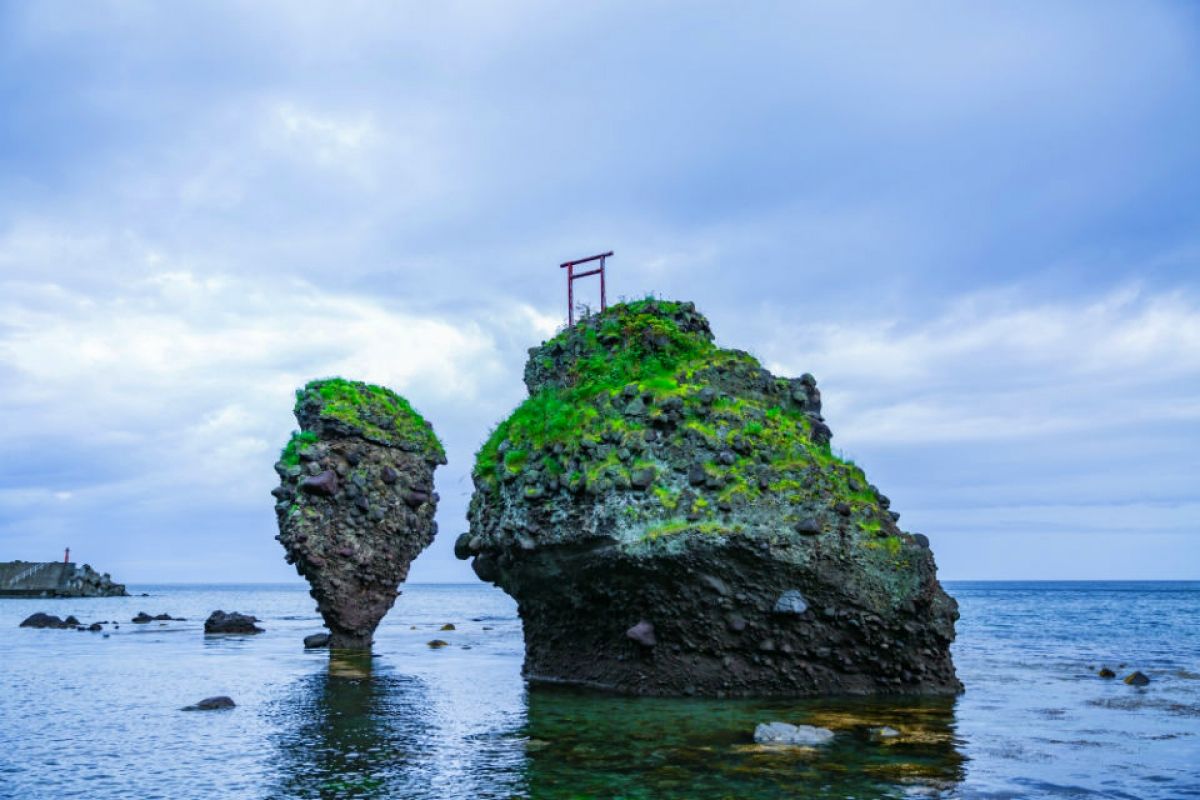The torii is a gate that stands at the entrance to the sacred area around the shrine. The distinctive form of the torii is recognized by people around the world as an icon marking the presence of a Shintō shrine. The torii signals that you are about to enter hallowed space, and it is customary to bow one’s head before passing beneath it.

The size and number of the torii depend on the scale of the shrine. When a shrine has multiple torii, the outermost, situated at the entrance to the shrine precinct, is typically the largest. It is called ichi no torii, or first gate. Each subsequent gate (ni no torii, san no torii, etc.) marks a transition to ever more sacred space as one approaches the sanctuary.
1.Morito Daimyojin (Morito Shrine)

Morito Daimyojin is a shrine in the Hayama town of Kanagawa Prefecture, which stands facing to the sea. The shrine has a history of more than 850 years, but the main shrine has been built only about 400 years ago. This shrine was built by a well known at that time Minamoto no Yoritomo, the first shogun of the Kamakura Shogunate.
Morito Daimyojin is stretching from the main building to the sea and at some distance away, on a small island, you could see a red Torii, which almost afloat on the sea. When the weather is good, you can even see the Mountain Fuji, Torii, and the lighthouse together in the parallel line. If you will come here during the sunset, you can enjoy a really stunning panorama.
There is also a wonderful sandy beach which spreads just in front of the Morito Shrine. It is called Morito coast and the summer here is a paradise for those who like swimming and resting on a warm sand.
2. Amanoyasugawara Gyobogaiwa

It is said to be the place where gods and goddesses gathered to confer with each other when Amaterasu-Omikami (the Sun-Goddess) hid herself in Heavenly Rock Cave, all the gods and goddesses tried to get the sun goddess Amaterasu to come out of the rock cave and end the darkness of the world.

This cave is also known as Gyoboga-Iwaya, originally there was only a shrine structure on the riverbank, but over the years many visiting pilgrims carried stones to the site and arranged them in piles The immense array of stone piles now standing on the Amayasu riverbank adds a mystical and fantastic aura to the site.
3. Torii gate at the entrance to Takeshima and Yaotomi Shrine

Takeshima is a small island with a perimeter of about 680 m, floating in the Mikawa Bay. You can walk across the Takeshima Bridge from the land on the other side, plus its the only place in Japan where a bridge runs through a Torii gate. The bridge is supposed to bring good luck to couples, so if you come with your significant other it is customary to walk the bridge together while holding hands. The whole island is designated as a natural monument, which is rare for an island, and it is home to five shrines. Among the five shrines, Yaotomi Shrine, dedicated to Ichikishimahimenomikoto, has been known by the name Takeshima Benten since ancient times and has been worshiped as a god for safe childbirth, matchmaking, and business prosperity.
4. Meoto Iwa – Maried couple rocks

Located in the sea off Futami in Mie prefecture are a couple of small rocky sea stacks: they are known as Meoto Iwa or the Married Couple Rocks. These rocks are seen as a representation of the union of the creators of the kami, the spirits worshiped in Shinto religion. The two stones are identified as Izanagi (husband) and Izanami (wife). Their union as a couple is very significant and divine to Shintoism, as they are the ones that created all the spirits of the world.

At the top of the larger rock stands a small torii, which is a traditional Japanese gate commonly found at the entrance of a Shinto shrine. It has a special meaning as it serves as a mark of transition from the earthly to the sacred. It plays a role in the worshipping of a sacred stone in the nearby Futami-Okitama Shrine.
Meoto Iwa is especially popular for its beautiful sunrise, particularly during the summer season. If you go there early in the morning you will be able to catch the sun rising between the two rocks. Other people visit the place during high tide, which is the time when the rocks are visibly separated by water.
5. Hokkaido Yoichi Ebisu Iwa & Daikoku Iwa

These two rocks – Iwa – are shintai: the physical entities harbor spiritual beings. They’re known as Ebisu Iwa (恵比寿岩) and Daikoku Iwa (大黒岩) because of their striking resemblance to the gods of that name.

To the left, Ebisu, the god of fishermen. He’s chubby, holds a fishing rod in one hand and a rather hefty red seabass in the other. To the right, Daikoku, the god of wealth. He’s often depicted with a golden mallet. Both will bring you a good fortune even if that doesn’t seem to be true of the nearby village.
It’s an ideal place to visit when the sun is highest in the sky (the rocks are often in the shade) or indeed at sunset.
6. Shirahige-Jinja Shrine

Shirahige-Jinja Shrine was founded in 1900, boasting the longest history for a shrine Omi. This is also one of the constituent elements of the Japan Heritage story. Against the backdrop of the lake island of Okishima, the sight of fishing boats going about their business between the torii gates in the offing is particularly stunning. Furthermore, the gates are illuminated at night.

Early morning is a particularly recommended time to visit, with the morning sun rising inside the Torii gate, and this has recently also become is a popular time to take photos.
Article: Nippon.com, , Japan travel, Japan Info, Off beat Japan
Photo: Zekkei Japan